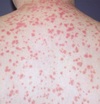Dermatology Flashcards
What is the Epidermis made from?
stratified (squamous) cellular epithelium.
What is the Dermis made from?
connective tissue
Where does the epidermis come from?
ectoderm cells which form a single layer periderm.
Where does the dermis come from?
mesoderm cells
What are Melanocytes?
pigment producing cells from neural crest.
What are the layers of the epidermis in order?
Keratin layer, granular layer, prickle cell layer and basal layer.
What does the skin consist of?
epidermis, appendages (nails, hair, glands), dermo-epidermal junction, dermis, sub-cutis (predominantly fat)
What muscle pulls the hair follicle in thermoregulation?
arrector pili muscle
What is the biggest component of the epidermis?
Keratinocytes
What are keratinocytes?
epidermal cell which produces keratin.
Where do keratinocytes grow from?
the basement membrane up to the epidermis.
What are the proper names for the layers of the epidermis in order?
stratum corneum, stratum lucidum, stratum granulosum, stratum spinosum, stratum basale
What is the outermost layer of the skin?
stratum corneum
What is the stratum lucidum?
A clear layer between the keratin layer and granular layer which is filled with eleidin, an intermediate of keratin.
What factors are responsible for the turnover of epidermal cells?
growth factors, cell death and hormones.
What is the keratin layer like in Psoriasis?
thick- this is due to the keratinocytes growing from the basement membrane upwards maintaining continuous regeneration of the epidermis.
What is the basal layer?
One cell thick with lots of intermediate filaments of keratin and are highly metabolically active. It is also known as stratum basale.
What is the prickle cell layer?
it contains large polyhedral cells with lots of desmosomes. They are intermediate filaments to connect to desmosomes. Also known as Stratum spinosum.
What is the granular layer?
2-3 layers of flat cells. It has a high lipid content and no cell nuclei. it is also known as stratum granulosum.
What are Corneocytes and where are they found?
differentiated keratinocytes that compose mostly all of the stratum corneum.
What are melanocytes?
they contain the pigment melanin (converted from tyrosine). They are derived from the brain?
What is Vitiligo?
when the melanocytes are attacked by T cells. it represents an autoimmune disease with loss of melanocytes.
What is Albinisim?
disorder where there is a genetic partial loss of pigment production
What is Nelsons Syndrome?
when the melanin stimulating hormone is produced in excess by the pituitary gland. it is caused by too much ACh causing hyperpigmentation.

























